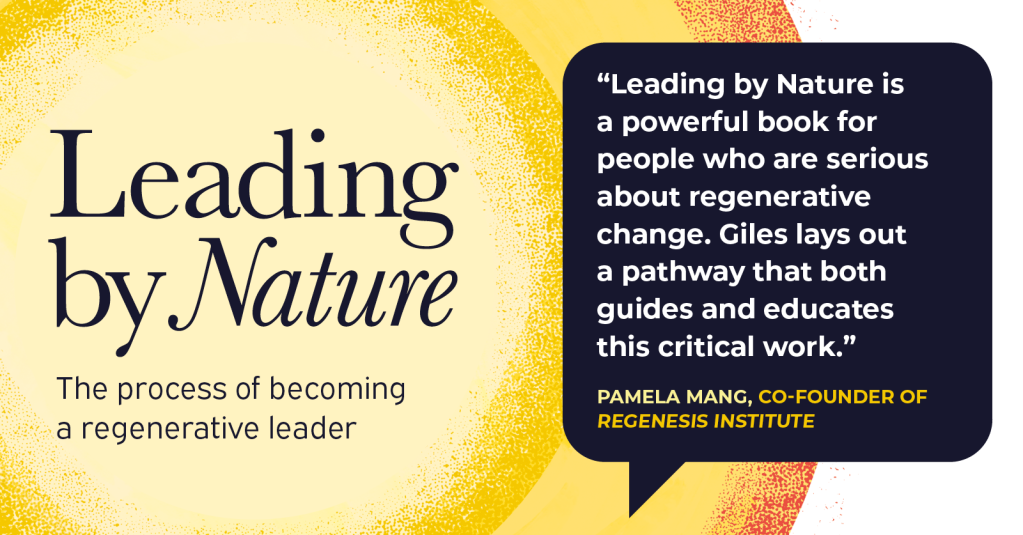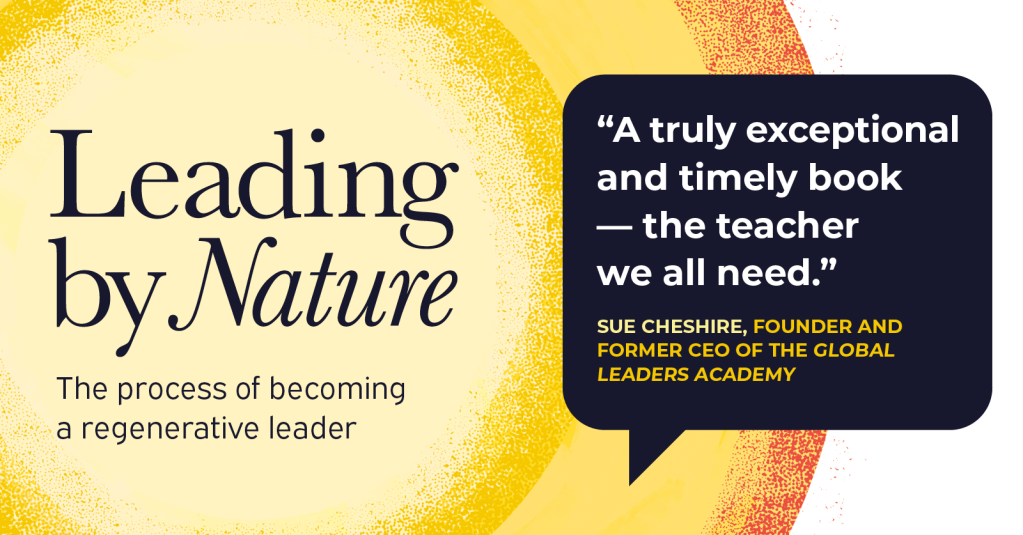Seven Ways to Think Regeneratively in 2024
Seven Ways to Think Regeneratively, by Giles Hutchins – please note that the first six ways were recently published in the Great British Brands 2024 edition, with Editor Lucy Cleland, see here for the full article)
1 Think in systems, networks and relationships
Since the Industrial Revolution, we’ve been conditioned to think mechanistically, viewing our businesses as something to manage and control in a top-down fashion with push-pull, carrot-stick levers, exploiting assets (including ‘human resources’) for short-term returns. This system – of business as machine – tends to undermine the future-fitness of the organisation in increasingly volatile and fast-moving climes. When power and control reside at the top, decision-making becomes far removed from the customer, and employees too can feel disempowered, robotic and inauthentic. In fact, Harvard Business School research tells us most leaders and employees are doing a second job no one is paying them for – that of managing other people’s impressions of themselves, covering up their weaknesses, playing politics, hiding uncertainties. This is not a recipe for success, undermining our individual and collective brilliance. Therefore, it pays to begin to think of the organisation less as a machine and more as an ecosystem full of human connectivity – between employees, customers, suppliers, partners, advisors, investors, social media advocates, families and friends, local communities, ecologies, etc – with a reciprocity that thrives on trust. As a business leader, reflecting on and tuning into the inter-relational nature of these systems helps to sense where there’s flow, impasse or latency waiting to be realised, or opportunities for transformation. Rather than chief executive officer think chief ecosystem officer – constantly scanning the relational systems to sense where there’s emerging potential.
2 Recognise that the inner and outer aspects of the business are inextricably linked
The ‘inner-nature’ of the living-organisation is its culture – not some HR charter or values poster on the wall, but the day-to-day ways in which people show up, share, exchange tacit knowledge, gossip on social media, co-create and connect in and out of the office. The ‘outer-nature’ is its brand, external communications, PR, stakeholder relationships, and impact on various groups outside the business. Both natures are connected so it will show up clearly in either aspect whether or not a business truly values authenticity, encourages courageous conversations, gives constructive feedback and offers developmental learning, or keeps within the machine mindset. Successful businesses will be those that synergise the inner and outer aspects so that all elements feel deeply connected.
3 Think circular not linear
A vital part of future-fit business is the widening of the business lens from merely transactional i.e. from a focus on selling stuff to customers in a linear one-way process, to participatory and circular, where customers re-engage with suppliers for recycling and upcycling services. Take one of my clients, the award-winning Vivobarefoot, which recycles worn shoes, thus keeping them out of landfill, and engages with customers – through offering 3D foot-scanning for customised shoes, and hosting online courses, tools and coaching, such as learning to run and breathwork. More often, the value we attribute to such exchanges is not limited to the price tag on the good or service. The organisations with the best ability to work with these relationships and exchanges across the board will be the most adept at navigating the emerging business landscape.
4 Think inter-generational and ‘glocal’
Amid the short-termism of many business decisions, many of us think individually about the kind of future we’re leaving for the next generation. While regenerative acts – such as composting, not wasting food or helping our neighbours – can happen at home, they should happen in our businesses too. Asking whether a business venture is actually enhancing life as opposed to just reducing its negative impacts does not distract us from our business endeavours, but deepens the creativity we unleash for doing things that provide proper value for the world. For example, Vivobarefoot is transforming its operations, supply-chain and organisational culture toward the principles of regeneration. Therefore, as well as making its products far more sustainable, it has evolved into being a natural lifestyle brand, where opportunities such as rewilding experiences are offered. And by acting ‘glocally’ (with local and global awareness), it supports a variety of initiatives involved in regenerating local ecosystems, which sparks all sorts of synergies and reconnects company success with social and ecological progress. Globally, it is involved in networks and conferences that work on society-wide solutions, such as the B Corp movement and United Nations COP conferences. This ‘glocal’ perspective challenges a narrowed view of wealth-creation limited to maximising short-term financial returns for shareholders, to thinking of wealth more holistically, in terms of regenerating community, nature, society and our home, Earth, upon which we all ultimately depend.
5 Think life-centric
As we get used to seeing the organisation-as-living-system, we start to value the importance of learning from life itself, in recognising that nature thrives through ever-changing inter-related systems within systems, just like our living-organisations. We participate in this life-centric reality whether we’re conscious of it or not. Each unique individual employee’s essence finds its tune within the team-essence, within the wider organisational essence that finds its tune within wider systemic interplays (business ecosystem, society, Earth). When we open up to life in this way, we realise that humans are immersed in a web of relationships, and to harm any of them is to damage our own selves and undermine our home. This life-centric sense of interconnectedness can inform how we lead and operate in business and beyond (this dove-tails with the 7th ‘way’ – Think Interconnection not Separation – covered below).
6 Think tensions, and the power they unleash
Learning to be comfortable with the uncomfortable is an important leadership skill. Tensions between individuals are inevitable, but handled correctly by working through them rather than suppressing them, can create crucibles for creativity. We can also learn from seeing how nature’s creative advance is impelled by tensions. There’s the primary tension of yin-yang, for instance. Yin represents stillness, inner-being, receptivity, and compassion; yang represents movement, outer-doing, responsiveness, and assertion. We need both in business. Sometimes we might need a little more yang, sometimes more yin. There’s also the divergence-convergence tension. Divergence is opening-up, creativity, exploration, etc; convergence is bringing-together, cohering around a sense of purpose, having clear roles, and suchlike. Too much divergence and chaos ensues; too much convergence leads to rigidity. Getting that tension just right is essential to allow for emergence. All living systems express themselves through the self-generating, self-organising property of emergence. Businesses are no different. Living-systems thrive on this edge of chaos (divergence) and order (convergence), and it’s that edge that enables adaptability and vitality across the living-organisation.
7 Think Interconnection not separation
Essentially, we are nature, we are ever-immersed in relationality steeped in consciousness. Separateness is an illusion we have created in our own minds, in reality everything inter-relates with everything else – energetic, informational, rhythmic; held within a depth of dimension one might call ‘metaphysical’, ‘source’, ‘the field’ or ‘quantum’. From the quark string humming away, the water tumbling down stream, the sapling and Mother tree, the bee and hive, to the leader and organization, there’s not just ‘systems nested within systems’ but ‘fields immersed within fields’, interpenetrated with intentionality. Think – Indra’s Net: living-systems participating within living-systems which participate within wider living-systems, reciprocating across both tangible-physical and intangible-metaphysical dimensions. Mind and matter interpenetrate, there is no separation. As the great scientist Albert Einstein noted, the greatest illusion in life is the illusion of separation.
Regenerative business is essentially about learning to work the way life works, nothing more, nothing less. For more on working the way life works, you may enjoy this recent article on Living Systems Awareness – Making Decisions Within Nature.
Giles Hutchins is a pioneering practitioner, keynote speaker, and executive coach known for his work in leadership development. His latest book is Leading by Nature: The Process of Becoming a Regenerative Leader.
Latest book and podcast series: Leading by Nature – The Process of Becoming a Regenerative Leader

If you are interested in joining a deep-dive two-day/overnight immersion late May this year - see more details here (The February immersion is already fulling booked) https://thenatureofbusiness.org/2023/10/05/leading-by-nature-embodying-next-stage-regenerative-leadership-consciousness-2/
Feel free to join the LinkedIn Leadership Immersions Group here

You may be interested in the full article on Regenerative Leadership in The Great British Brands 2024 edition with editor Lucy Cleland who recently visited Giles Hutchins and experienced a regenerative leadership immersion at Springwood Farm, Sussex, UK: https://www.countryandtownhouse.com/culture/regenerative-business/

